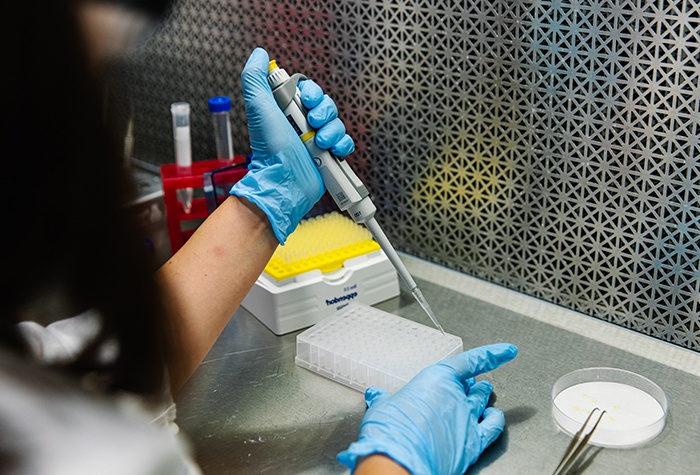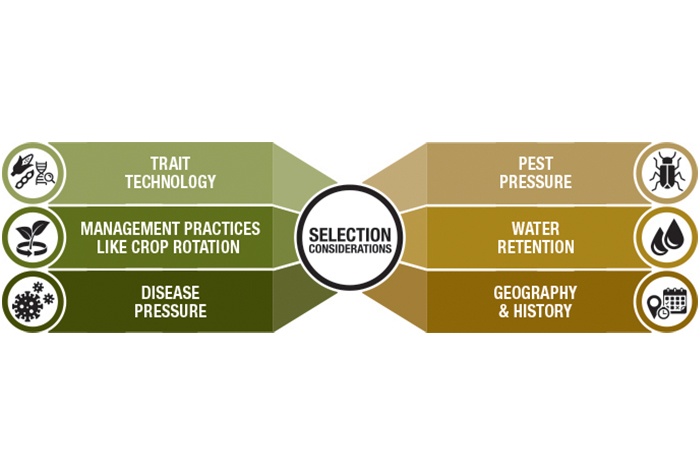- HI-Edit™ technology quickly introduces genetic changes in crop varieties.
- The goal is to deliver better seeds to growers, faster.
- The program is currently focused on corn, but it can be expanded to other crops.
Consider your smartphone. It places more computing power at your fingertips than people 20 years ago could imagine, and it’s right there in your pocket. The first computers were the size of entire rooms, immensely expensive, and required specialized training to operate. Computer technology wasn’t widely distributed, but thanks to the invention of the microchip and other technological improvements, smartphones are commonplace. The smartphone is amazing because of what it can do, but also because it’s right there in your pocket.
Tim Kelliher suspects HI-Edit™ technology will revolutionize seed production in a similar way.
“HI-Edit is basically a faster way to bring biotech to farmers,” says Kelliher, Ph.D., head of technology development and science fellow with Syngenta Seeds and one of the inventors of the HI-Edit technique. “It allows us to make genetic changes to commercial varieties without a lot of lab and greenhouse costs and time.”
How HI-Edit Helps
HI-Edit, or Haploid Induction EDITing, introduces genetic changes in crop varieties quickly. This new biotechnology cuts the genome-editing process down to one step by installing CRISPR, a protein enzyme that allows researchers to precisely alter DNA sequences and modify gene function, in a haploid induction line. Researchers then cross the HI-Edit line to commercial crop varieties, and the CRISPR makes a precise modification in the DNA sequence of those varieties. Because it’s in a haploid inducer line, the CRISPR enzyme and the haploid inducer DNA are eliminated from the resulting seed, which contains only the original crop variety’s genetic material with the modified genetic sequence.
Rather than inserting CRISPR to edit all commercial varieties or making edits and breeding them into commercial varieties, a CRISPR insertion to a HI-Edit line need only be made once. The researchers then use that line to fertilize plants from the commercial varieties. The resulting embryos inside the seeds match the original commercial varieties except for the desired trait. This process removes the need for generations of selection and backcrossing or making individual CRISPR edits to many commercial varieties, saving vast amounts of time and resources.
“Where HI-Edit comes in is when we want to make specific changes to a bunch of different varieties,” Kelliher says. “If we tried to use CRISPR on all commercial varieties it would take too much time, money, technology and expertise. So instead of making the edit in a donor line and crossing it in, we make it in the haploid inducer line, cross it once and put the edit directly into those commercial varieties.”
HI-Edit is basically a faster way to bring biotech to farmers. It allows us to make genetic changes to commercial varieties without a lot of lab and greenhouse costs and time.
HI-Edit cuts down the time of introducing new traits by years and at a much lower cost. It will potentially offer growers quicker access to commercial seed varieties with traits like better protein, drought tolerance, disease resistance and more. The goal is to deliver better seeds to growers, faster, through innovation.
“This is good news because growers are going to get the latest and greatest traits by a simple change in the genetic sequence years sooner than they would otherwise,” Kelliher says.
Genome Editing vs. GMOs
Genetically modified organisms (GMOs), according to traditional thinking, are organisms that have had a foreign piece of DNA, a piece that’s totally different from what’s in the natural organism, inserted into them. A well-known example is Bt11 corn, which uses a gene from Bacillus thuringiensis (Bt), a common soil bacterium that produces several insecticidal proteins.
The Bt gene is responsible for producing a protein toxic to European corn borer. The Bt11 corn, now producing this protein, kills European corn borer larvae when they feed on the plant. This sort of modification, the insertion of a completely foreign bacterium gene into the corn genome, is a traditional GMO.
Genome editing, on the other hand, is when scientists make slight alterations to a genetic sequence already within the organism. The HI-Edit process falls under the genome editing category, rather than GMO.
The U.S. Department of Agriculture (USDA) issued regulatory guidance on genome editing that establishes exemptions for plants modified by genetic engineering where the modification could otherwise have been made through conventional breeding. At this time, regulatory guidance on HI-Edit will depend on the type and size of the edits. This guidance is currently evolving as the USDA’s Animal and Plant Health Inspection Service (APHIS) replaces the current review process. Under the new process, developers voluntarily submit information on genetically modified plants to APHIS, which then determines if the modified plant requires USDA approval.
Exportation of genome-edited products is also influenced by the fact that regulations vary from country to country.
“If we are to foster an environment that supports continued innovation and maintains the U.S.’ leadership role at the global level, we must ensure that USDA works closely with the Food and Drug Administration and the Environmental Protection Agency to ensure consistent, science-and risk-based policies across the U.S. government, while continuing to take a leadership role in working towards alignment at the international level,” says Mary Kay Thatcher, senior manager, federal government and industry relations at Syngenta.
The HI-Edit process is currently focused on corn but can be used on other crops like rice and wheat. Syngenta hopes to expand the process for use on other crops. The anticipated release date for gene-edited seeds using this process is still a few years away, but Syngenta sees the promise a biotechnology like this has for helping farmers get the most from their land. Kelliher says he is hopeful that in the not-too-distant future, this exciting biotechnology will deliver the latest and greatest seed traits to farmers on a larger scale than ever before.
Kelliher believes new technology is wonderful. Distributing it widely to those it benefits is even better.
PLANT BREEDING 101
In the context of plant breeding, a trait is a characteristic exhibited by a plant. It could be something like drought tolerance, stalk strength, resistance to a specific disease, or increased yield. The ag science community constantly researches which genetic sequences impact traits that bring value to farmers. Scientists usually learn about the genetic sequence responsible for a desirable trait while studying one specific variety. The challenge becomes how to transfer that desirable trait into many varieties.
Traditionally, the variety with a desirable trait is bred with other varieties in which scientists also want it to appear. Plant breeders carefully select and backcross the offspring of those varieties that exhibit that trait and then repeat that process with each generation until eventually a stable variety with the trait emerges. That process typically takes six or seven plant generations, requiring a significant investment over several years.
Syngenta currently invests about $1.5 billion in research and development each year. If Syngenta discovered a genetic sequence that improved drought tolerance and decided to add that trait into the many existing varieties optimized for specific geographies, the traditional process would require breeding and backcrossing each existing commercial variety.
HI-Edit, however, makes it possible to move those lines more efficiently. The HI-Edit process leans into the basics of sexual reproduction:
When a sperm with its male chromosomes fertilizes an egg with its female chromosomes, together they form a zygote, which contains chromosomes from each parent. The sperm or the egg is a haploid, containing only a single set of chromosomes. The zygote is a diploid, containing a complete set of chromosomes from each parent.
But some plants are haploid inducers. Haploid inducers cause female plants to produce seeds containing embryos that include only one parent’s genetic material, or a haploid embryo.
That’s where HI-Edit goes to work.
Cautionary Statement Regarding Forward-Looking Statements
This document contains forward-looking statements, which can be identified by terminology such as ‘expect’, ‘would’, ‘will’, ‘potential’, ‘plans’, ‘prospects’, ‘estimated’, ‘aiming’, ‘on track’ and similar expressions. Such statements may be subject to risks and uncertainties that could cause the actual results to differ materially from these statements. For Syngenta, such risks and uncertainties include risks relating to legal proceedings, regulatory approvals, new product development, increasing competition, customer credit risk, general economic and market conditions, compliance and remediation, intellectual property rights, implementation of organizational changes, impairment of intangible assets, consumer perceptions of genetically modified crops and organisms or crop protection chemicals, climatic variations, fluctuations in exchange rates and/or commodity prices, single source supply arrangements, political uncertainty, natural disasters, and breaches of data security or other disruptions of information technology. Syngenta assumes no obligation to update forward-looking statements to reflect actual results, changed assumptions or other factors.
© 2022 Syngenta. HI-EditTM and the Syngenta Logo is a trademark of a Syngenta Group Company. All other trademarks are the property of their respective owners.







